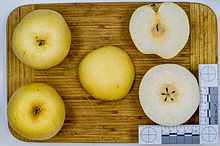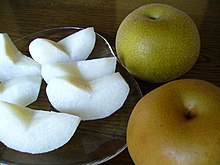Nashi pear
| Nashi pear | ||||||||||||
|---|---|---|---|---|---|---|---|---|---|---|---|---|

Nashi pear (fruit) |
||||||||||||
| Systematics | ||||||||||||
|
||||||||||||
| Scientific name | ||||||||||||
| Pyrus pyrifolia | ||||||||||||
| ( Burm.f. ) Nakai |
The nashi pear ( Pyrus pyrifolia ) ( Japanese : ナシ ( 梨 ), nashi , German "pear") is a plant from the genus of pear ( Pyrus ). The type of plant and its edible fruit - fruits are often called Japanese pear , Korean pear , Asian pear , Chinese pear , Kumoi or - because of their shape and taste - as apple-pear ( Bapfel /Birpfel ). The term nashi pear is a double, because nashi is the Japanese word for pear.
description
Vegetative characteristics
Pyrus pyrifolia grows as a tree and reaches heights of 7 to 15 meters. The bark of the branches is purple-brown and the bark is dark brown. The narrow, egg-shaped buds have bud scales that are woolly hairy on the edge and on the tip.
The leaves are divided into a petiole and a leaf blade. The petiole is 3 to 4.5 cm long and initially woolly hairy. The leaf blade is 7 to 12 cm long and 4 to 6.5 cm wide. The leaf surface is initially hairy brown and woolly, later smooth. The leaf margin is serrated to a point. The membranous stipules are 1 to 1.5 cm long.
Inflorescences and flowers
The umbel-shaped, racemose inflorescences contain six to nine flowers. The linear bracts are membranous and 1 to 1.4 cm long. The initially sparsely hairy flower stalk is 3.5 to 5 cm long. The hermaphrodite, radially symmetrical , five-fold flowers have a diameter of 2.5 to 3.5 cm. The flower cup (hypanthium) is cup-shaped. The five triangular-egg-shaped sepals are about 5 mm long. The five white petals are egg-shaped, 1.5 to 1.7 cm long and nailed short. The 20 stamens are about half as long as the petals. The five or vierfächerige ovary contains two ovules per subject. The five, rarely four styles are smooth and almost as long as the stamens.
The flowering period begins in early April and lasts until early May.
The number of chromosomes was 2n = 34, 51.
fruit
The almost spherical fruits have a diameter of 2 to 2.5 cm (natural forms, cultivated varieties are larger) and have a thin shell that is smooth or rough depending on the variety. Their basic color is light yellow throughout, and sun cheeks appear shortly before harvest. The pulp is very juicy and has a sweet and sour aroma that is reminiscent of apple, pear and melon. The fruits contain vitamin C , potassium , calcium and phosphorus .
Nashi fruits are ripe for picking for around three weeks from August or early September.
Nashis can be eaten straight and raw, the shell is also edible, only the core has to be removed. The pears are also suitable for making jam or desserts such as compotes and cakes. In addition, they go well with cheese and ham, game dishes and spicy (winter) salads - like local pears.
Occurrence
The Nashi pear originally comes from China . Today, however, it is widespread across East Asia and Japan .
For several years it has also been grown in Chile , France , Germany , Italy and the USA . It is also bred in Australia and New Zealand . In this country it has been available since the 1960s.
Cultivation and varieties
Due to the large-scale cultivation in Japan, there are many different varieties. Over 1200 types of Nashi are known in Japan alone.
The total acreage there was 13,752.9 ha in 2005, with the most commonly grown varieties being: Kōsui ( 幸 水 ) with 5383.5 ha (39.1%), Hōsui ( 豊 水 ) with 3663.2 ha (26.6%) ), Nijisseiki ( 二十 世紀 ) with 1591.1 ha (11.6%) and Niitaka ( 新 高 ) with 1305.1 ha (9.5%).
The endings of the variety names indicate a smooth ( -seiki , German "century") or a rough ( -sui , German "water") skin of the fruit.
Intersections
- 'Benita' is a cross between the Nashi pear ( Pyrus pyrifolia ) of the Hosui variety and the cultivated pear variety ( Pyrus communis ) Général Leclerc (a European pear variety), which the Swiss Peter Hauenstein achieved in 1985. This pear combines the advantages of both parent varieties, so it is very juicy and yet crunchy. It can be eaten straight from the tree, but can still be stored for up to three weeks after harvest.
swell
- Gu Cuizhi & Stephen A. Spongberg: Pyrus in the Flora of China , Volume 9, p. 177: Online. (Section description)
Individual evidence
- ↑ Nashi pear. In: Obstlexikon. Retrieved August 7, 2013 .
- ↑ Nashi pear. In: Obstlexikon. Retrieved August 7, 2013 .
- ↑ ナ シ 品種 別 栽培 面積 平 成 17 年度 . 独立 行政 法人 農業 ・ 食品 産業 技術 総 合 研究 機構 ( National Institute of Fruit Tree Science ), 2005, archived from the original on January 22, 2012 ; Retrieved April 25, 2009 (Japanese).
- ↑ Benita® ( Memento of March 4, 2016 in the Internet Archive ) (accessed on: August 8, 2012).
- ↑ Hosui ( Memento of February 19, 2016 in the Internet Archive ) (accessed on: August 8, 2012).
- ↑ Général Leclerc ( Memento of January 14, 2016 in the Internet Archive ) (accessed on: August 8, 2012).





